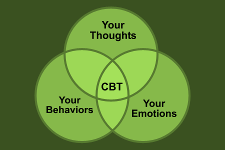Information about Psychological Services
Dr. Stranges’
primary approach to therapy is cognitive-behavioral though he borrows flexibly from other theoretical orientations depending on the needs of the client. Cognitive-behavioral therapy aims to help a client to consider alternative ways of interpreting or explaining situations when their current methods of thinking are creating or exacerbating stress and pain. Cognitive therapy, as practiced by Dr. Stranges, is embedded in collaborative conversation with the client as specific problems are identified, and solutions are generated and evaluated. Dr. Stranges
actively helps the client to find solutions to their problems but only at a pace that the client is able to handle.
There are numerous methods employed in cognitive-behavioral therapy including identifying problems; understanding the connections among situations, thinking, emotions, behaviors, and even physiological reactions; assertive communication skills; relaxation therapies; mindfulness meditation; practicing total self-acceptance; goal-setting; changing dysfunctional thought patterns; understanding deeper-seated emotional blocks; effective problem-solving; understanding developmental changes that come with aging and shifting accordingly; and many others..
Therapy/Counseling Services
Psychotherapy/Counseling - Individuals may work on a variety of issues including low self-concept, anxiety, depression, relationship difficulties, problems at work, anger episodes, indecisiveness, procrastination, substance use, or decision making.
Marital Counseling - Couples may resolve communication difficulties or other issues that may be preventing them from experiencing a healthy and loving relationship.
Family Counseling - One or more family members may benefit from counseling to resolve difficulties and to promote healthier family functioning.
Self-Enhancement Psychotherapy/Counseling - Individuals may work toward specific or overall self-improvement goals. Individuals may set goals to communicate more effectively, enjoy healthier relationships, accomplish goals, handle stress more effectively, be calmer, make better decisions, become a better listener, be more open-minded, have more confidence, become more optimistic, or achieve greater career success.
Evaluations
Dr. Stranges
is trained and experienced in the use of psychological testing including tests of intelligence, academics, personality, career interest, emotional symptoms, executive functioning, and behavioral patterns. These tests can sometimes be very helpful in quickly delineating issues and concerns that might otherwise require much more time to unfold.
Psycho-educational Evaluations - Evaluations help to determine the root causes of student's difficulties in learning, reading, writing, or mathematics, and to design interventions that address the causes. Evaluations can be designed for children in elementary school through adults in colleges or workplace environments who may require accommodations for success.
Appointments can be made by phone at
(609) 390-4383.

